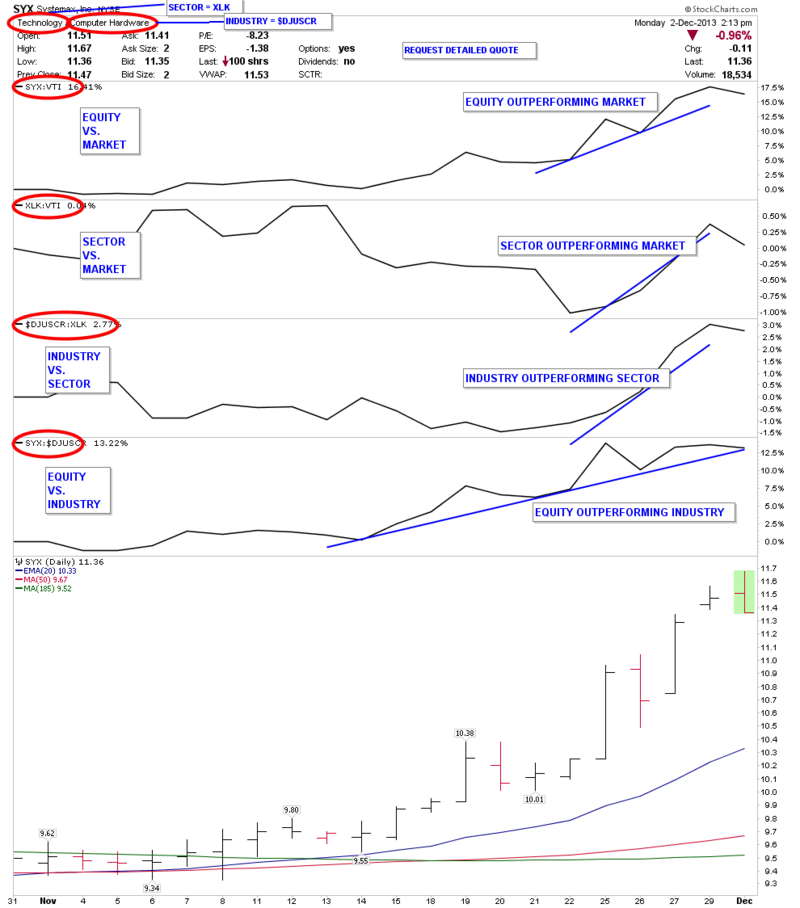
We have all heard the maxim “the trend is your friend”. On the other hand, 4 trends become your best friends and should become part of the family. This is indeed the basis for my probability buster chart. Understanding the inter-relationships between markets, sectors, industries and individual equities is crucial. Most investors understand that “a rising tide lifts all boats.” The smart money takes it deeper and knows that the height of the rising tides varies significantly amongst different sectors and industries. The smart money also knows that big bucks are made by aligning the strongest sectors and industry groups, thereby trading in harmony with the most powerful rising tides within the market. Think of it as relative strength analysis on steroids that highlights stocks for which the big institutions have a growing affection. This ‘growing affection’ results in accumulation which, put in equivalent terms, significantly raises the probability of an uptrend for the equity in play.
Not too long ago, the institutions had peerless expensive investment tools and all the advantages, resulting in a playing field that was far from level. Today, on the other hand, individual investors have inexpensive yet powerful relative-performance charts such as the one below. These are the simple steps necessary to reproduce this ‘Probability Buster Chart’. I’ll use Systemax Inc. (SYX) as an example.
- Under ‘Chart Attributes’, check ‘Full Quote’.
- This shows you that SYX is in the Technology Sector, and within that sector, it’s part of the Computer Hardware Industry.
- Under ‘Indicators’, you pull-down ‘Price Performance’ and enter 4 parameters for each of the price relative charts. The parameters are these:
a. SYX : VTi – I use VTi for the total market. It’s Vanguard’s ETF and a good proxy.
b. XLK : VTi -- The Tech Sector relative to the total market.
c. $DJUSCR : XLK – The Computer Hardware Industry relative to its Sector.
d. SYX : $DJUSCR – The equity relative to its Industry group
The objective is to align all 4 up-trending price relative charts. When the tide is rising on all four fronts, the relative strength probabilities are working for you with all four trends.
To speed up the production of this format, I save a ‘ChartStyle’ that I call ‘Price Relative’. This can be achieved by using ‘X’ as a placeholder for the Sector and Industry group symbols. For example, in the above situation.
a. SYX : VTi There’s no need for a placeholder here because SYX gets automatically replaced when you input your equity symbol of choice up top.
b. XLX : VTi – The second ‘X’ in ‘XLX’ is just a placeholder to remind you to input one of the 9 Sector symbols.
c. $DJUSXX : XLX – The last two ‘Xs’ in the industry group symbol are placeholders for the Industry symbol, just as the second “X” in the Sector symbol.
d. SYX : $DJUSXX – The last two ‘Xs’ in the Industry group must be input with the appropriate Industry Group symbol to produce a meaningful chart.
Once you get familiar with the layout, the visual analysis benefits will be immediate. May the oracle of probabilities be with you!
Trade well; trade with discipline!
-- Gatis Roze

